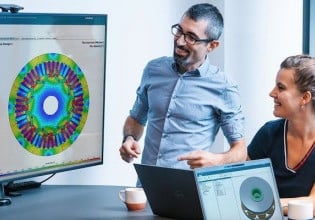While cell phones, laptops and cars become more energy efficient, the development of one important ingredient common in all these devices, and many more, has lagged: the batteries used to power them.
“In any given battery, something is either very rare or it’s toxic or it’s expensive. Those are the things that have been plaguing the battery industry,” said Apparao Rao, the R. A. Bowen Professor of Physics at Clemson University and director of the Clemson Nanomaterials Institute.
For example, today’s lithium ion batteries have high power density (they recharge fast) and high energy density (they stay charged a long time). But lithium is rare, expensive and toxic. It can also develop dendrites, like splinters, that can short-circuit a battery and lead to a fire.
Rao; Ramakrishna Podila, assistant professor of physics and astronomy; and their teams at the institute are replacing lithium with aluminum as the key element of batteries of the future.
“We wrap food in aluminum foil,” Rao said. So, it’s non-toxic. It’s also much more plentiful than the metal currently in widespread use, lithium — 8 percent of the Earth’s crust vs. 0.006 percent — making it cheaper.
Aluminum also transfers energy more efficiently. Inside a battery, the element — lithium or aluminum — give up some of their electrons, which flow through external wires to power a device. Because of their atomic structure, lithium ions can only provide one electron at a time; aluminum can give three at a time.
“That’s the real kicker,” Rao said. “That’s very beneficial for safer and better batteries.”
Still, aluminum ion batteries designed by other researchers have not performed as well as lithium ion batteries.
The Clemson team thinks they know why. In a paper published in journal Nano Energy, they describe how they were able to get aluminum ion to perform better than previously tested aluminum ion batteries.
“The problem isn’t that aluminum ions are deficient,” said Anthony Childress, a graduate student at the Clemson Nanomaterials Institute and the first author of the Nano Energy paper. “It’s that unlike lithium ions that have been around for a while, we do not know much about how aluminum ions behave inside the battery.”
The electrode in a battery is like a bucket and the electrical charge is like sand inside the bucket. If the sand starts to flow out, the speed at which it flows is the current. The greater the speed (the larger the current) the quicker the bucket is empty and the sooner the battery goes flat. The more sand you store in the bucket, the longer the current lasts.
Clemson found a way to pack more sand in the bucket and used tools to confirm the bucket was full.
Their new battery technology uses aluminum foil and thin sheets of graphite called few-layer graphene as the electrode to store electrical charge from aluminum ions present in the electrolyte.
“We knew that aluminum ions could be stored inside few-layer graphene,” Podila said. “But the ions need to be packed efficiently to increase the battery capacity. The arrangement of aluminum ions inside graphene is critical for better battery performance.”
“Previous attempts by other researchers to make high-capacity aluminum batteries were not very successful,” said Jingyi Zhu, a recent Clemson graduate.
One explanation for lower performance in other labs could be that cathodes had defects, like holes in the bucket holding sand. When labs tested their batteries, they thought their cathodes were full of ions, but they weren’t.
Previous work by the Clemson physicists carefully studied the capacity of few-layer graphene, so they knew what to expect. They also used their expertise in Raman spectroscopy, a method of identifying and measuring molecular signatures, to test their aluminum ion batteries and confirm capacity.
“These aluminum batteries can last more than 10,000 cycles without any performance loss,” Podila said. “Our hope is to make aluminum batteries with higher energy to ultimately displace lithium-ion technology.”
The next step toward a commercially viable aluminum ion battery is lowering the cost. Although aluminum is relatively inexpensive, the electrolytes are pricey, Rao said.
“This is a new battery with a new and better chemistry, which needs to be fine-tuned for commercial application,” Rao said. “We need to make it scalable enough so its cost comes down.”
“It’s an interesting game,” creating more efficient sources of electricity, Rao said. “You know what needs to be tweaked, but how do you go about doing it? That’s what makes it fun for us!”






